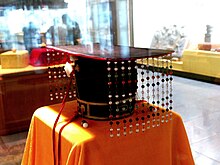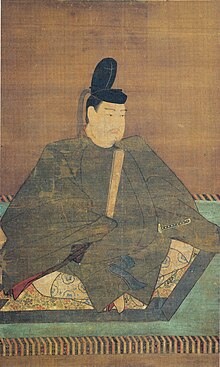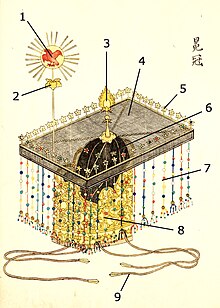Benkan
[1] In ancient Japan, emperors and nobles wore metal crowns made of gold, silver, and gilt bronze, influenced by the Korean peninsula.
[2] In addition, a sun-shaped ornament was added to the top of the benkan, creating a uniquely Japanese style of crown.
The benkan, hōkan, and nikkeikan crowns made in the Edo period (1603–1867) have each survived, but as imperial treasures (御物), these are not usually shown to the public.
[4] In ancient Japan, it was customary to use flowers, branches, and leaves of plants and trees as hair ornaments or to wrap them around the head.
[5] In the Kofun period (Mid 3rd century-7th century), influenced by the Korean peninsula, emperors and nobles began to wear metal crowns of gold, silver, or gilt bronze decorated with botanical patterns.
The crowns were made of brocade or patterned cloth, and were further adorned with gold or silver floral ornaments.
"[6][a] According to the Nihon Shoki (Chronicles of Japan, 720), these hair ornaments, also called uzu, were attached to caps on New Year's Day and special occasions, and depending on rank, uzu were made of gold, leopard tails, or bird tails.
Its shape is estimated to have been similar to that of Emperor Kōmei's benkan of the Edo period (1603–1867), an ancient metal crown topped with a Chinese mianguan-like board with chains of pearls hanging from it, and a unique sun ornament.
Both the ben (冕) and kan (冠) in benkan (冕冠) are Chinese characters related to crowns.
12 (established in the first half of the 10th century), explains that the Chinese mianguan is called tama no kōburi (玉乃冠, lit.
The benkan worn by the emperor in the Edo period consisted of a metal frame placed on top of an openwork gilt-bronze base called the oshikazura (押鬘), with forty-eight jeweled chains hanging from the edge of the frame, twelve on each side.
[14][15] Another significant difference from the Chinese mianguan was the sun-shaped ornament mounted on a benban (square board) at the top of the crown.
[14] The openwork metal crown with floral and arabesque patterns surrounding the cap is another feature not found on Chinese mianguan.
Dohi Tsunehira (1707-1782), a scholar of court rituals, proposed the theory that it was not a benkan, but rather a tamakazura (玉鬘), an ancient necklace.
[17] Among the Shōsōin treasures, there is a benkan worn by Emperor Shōmu that has been damaged and is called Onkamuri Zanketsu (御冠残欠, lit.
However, metal openwork pieces featuring phoenix, cloud, and arabesque patterns remain, along with pearls, coral, and glass beads threaded through the structure.
Minaoto no Morofusa's diary, Doyūki (土右記, 11th century), describes the characteristics of the benkan.
[19] According to the description, there is an inner crown (cap) made of thin black silk called koji (巾子), and kushigata (櫛形) are placed in front and behind it.
The kushigata is interpreted as an ornament consisting of a gold frame with a thin silk covering inside.
Stems with jewels adorning their tips are arranged in rows, extending from the four sides of the square board.
At the top of the crown is an ornament in the shape of a sun, consisting of two pieces of crystal (likely hemispherical), within which is a three-legged red crow.
This portrait depicts Emperor Go-Daigo undergoing the Abhisheka (灌頂, kanjō) ceremony of the Shingon Buddhism in 1330, and is said to have been completed on October 23, 1339, after his death.
There are theories that this form of benkan over kanmuri is a non-photorealistic "pictorial expression,"[23] or that it is an unrealistic and impossible way of wearing the crown, referring to the statue of Prince Shōtoku and aiming to portray Emperor Go-Daigo as sanctified.
[25] In Japan, there is a theory that Empress Kōken's benkan in the Shōsōin Repository may have been a removable form.
According to the description, the hōkan had a low koji height, an oshikazura (openwork gold crown), and three branches extending from it, each with a floral ornament at its tip.
[19] The low height of the koji is thought to be due to the fact that women did not wear topknots like men.
The difference from the hōkan described in the Doyūki is the absence of the koji itself, and instead there is the addition of a sun-shaped ornament, as in the benkan.











